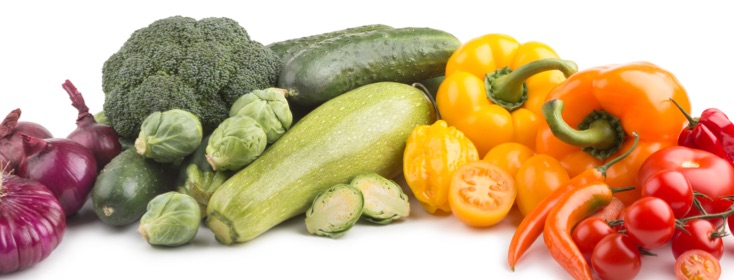Are Certain Fruits and Vegetables Better for Weight Loss Than Others?
Of course all fruits and vegetables are good for you, but it’s important to understand the differences between them when planning a balanced diet. First, let’s get one thing straight: we would never counsel against a specific fruit or vegetable. Fruits and vegetables in general are extremely nutritious, and they almost always have fewer calories than meat, dairy, and other food groups. However, we as humans do need variety, and it’s been found that some fruits and veggies are indeed better for weight loss than others. At the most basic level, high water content vegetables, like cucumbers, tomatoes, and celery, fill us up and have fewer calories than denser vegetables like potatoes, corn, and peas.
When it comes to the types of fruits and vegetables you eat, focus on getting a good variety of colors to balance out your nutrient intake. But first, you need to make sure you’re getting enough to begin with. Less than 10% of Americans are eating the recommended 2-3½ cups of vegetables every day (1) and that means you’re not getting enough fiber. Once you’ve mastered eating enough veggies, you can then take a look at the types of veggies you’re eating. Aim for ½ cup to 1 cup of starchy veggies every day (5 cups/week), and the rest should be non-starchy.1 Think of it like a 3:1 ratio of non-starchy to starchy veggies. Don’t forget about fruits: you need 2 cups every day of those as well. If all of these numbers are making your head spin, think of it this way: eat a small portion of starchy veggies once a day on most days of the week, or not at all 1-2 days/week.
And take note that not all starchy vegetables are nutritionally equivalent, either. If you are looking for a starchy side to go with your chicken, opt for roasted sweet potatoes or acorn squash instead of white potatoes. Sweet potatoes and squash are rich in beta-carotene and antioxidants, so they pack more of a nutritional punch than regular white potatoes. Peas and legumes are also starchy but have a better nutrient profile than white potatoes. Legumes, while not technically veggies, are packed with protein and fiber, so they can be the base of any healthy meal. Since starchy veggies are still high in calories and carbohydrates, overdoing them can still be an issue for those watching their weight or with diabetes, despite the nutrient density of these foods. As always you are your own best detective at determining which foods in what amount impact your blood sugar levels!
If you find it overwhelming to remember which types of fruits and vegetables are better for you, think about it this way: If the fruit or vegetable is crisp and/or watery, then give yourself the green light. If the fruit or vegetable is creamy and/or the texture reminds you of a potato, then it’s likely a starchy vegetable – give yourself the yellow light for these; in other words, eat these in smaller portions. Remember that ½ cup - 1 cup is perfect for a single day’s intake of starchy veggies.
Here are some tips to keep your starchy fruits and vegetables in balance:
- Steam string beans instead of peas to go with your fish.
- Top your oatmeal with blueberries and strawberries instead of a whole banana (or just eat half the banana).
- Make adjustments throughout the day: If you eat potato hash browns with your Saturday breakfast, remember to stick to non-starchy veggies for the rest of the day. Keep in mind what you’ll be having for dinner, too, and allow that to inform your decisions throughout the day.
- Next time you make mashed potatoes, try adding sweet potatoes and pureed steamed cauliflower to add extra color and nutrients while decreasing the calories.
- At Mexican restaurants, opt for pico de gallo instead of corn salsa or go for a mixture of both.
- Snack on slices of cucumber, baby carrots, and celery dipped in hummus.
- Usually steam up a sweet potato with dinner? Great! Split large ones in half, and sauté a non-starchy veggie to have with it for balance (try spinach, mushrooms, or caramelized onions).
- Instead of white rice with dinner, try making cauliflower rice by pulsing raw cauliflower in a food processor until the small pieces look like rice. You can also bought rice cauliflower washed and ready to cook at many grocery stores. Then steam for a minute or sauté just until slightly soft.
- Give cauliflower pizza a try. It’s a family favorite! Simply steam finely chopped cauliflower or cook it in the microwave after it’s been pulsed in the blender. Combine with a couple of egg whites, parmesan cheese, herbs, and a tablespoon of olive oil. Scoop mixture onto a greased and lined sheet pan and form your pizza crust. Par-bake, then add your toppings. Bake until golden brown. You can use the same mixture to make baked cauliflower tots: scoop little mounds of the cauliflower mixture onto a sheet pan that’s been laid and greased, and form the mounds into little pillow shapes. Bake until golden brown.
Bottom line, if you’re getting enough fruits and vegetables every day, you’re already doing way better than most Americans. But if you’re looking to up your diet game, start paying attention to the types of fruits and veggies you’re taking in—monitoring your starches can be a game changer.

Join the conversation